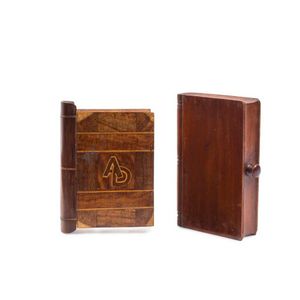Australian Wood Book Boxes
You must be a subscriber, and be logged in to view price and dealer details.
Subscribe Now to view actual auction price for this item
When you subscribe, you have the option of setting the currency in which to display prices to $Au, $US, $NZ or Stg.
- Huon Pine - Named after the Frenchman who discovered the Huon River in Tasmania, it is an extremely slow growing and long living tree. Huon pine is native to Tasmania, and it can grow to an age of 3,000 years or more. The wood contains oil that retards the growth of fungi, hence its early popularity in ship-building in convict-era Tasmania. The timber is a warm yellow colour, finely grained, and was popular for household furniture in the Victorian era. Interestingly, much Huon pine furniture was made in South Australia. Huon pine is a protected species and only limited quantities are available nowadays, for craftsmen to manufacture small items such as platters, sculptures and other decorative objects.
- Blackwood - One of the best known and most widely used Australian timbers, blackwood (acacia melanoxylon), is a member of the Acacia (wattle) family and grows in eastern Australia from about Adelaide in South Australia, as far north as Cairns in Queensland.
The largest, straightest and tallest trees come from the wet forest and swamps of north-west Tasmania where it is grown commercially.
Blackwood timber colours range across a wide spectrum, from a very pale honey colour through to a dark chocolate with streaks of red tinge.
The hardwood timber has been commonly used in the production of furniture, flooring, and musical instruments in Australia from the late 19th century. However, the straight grain timber is not the most prized or valuable, that honour falls to blackwood with a wavy, fiddleback pattern, which is used both in the solid and as a veneer. Fiddleback was only used on the finest examples of furniture.
This item has been included into following indexes:
- boxes, function - bible box and book boxes 67
- boxes, material or decoration
Visually similar items

de RAPIN, Paul [1661-1725] translated by TINDAL Nicolas [1687-1774] 'The HISTORY of ENGLAND' Vol. 1 [1743], Vol. 2 [1743], Vol.3 [1744], Vol.4 [1745], Vol.4 Part 2 [1747] plus a volume of 65+ maps and charts by Searle or Basire 'For Mr Tindal's Continuatio

An Australian cedar book box, stamped 'D.Gaskell', late 19th century

A miniature Tasmanian timber book box with applied gold map of Tasmania, 10.5 cm high, 8 cm wide, 3 cm deep

Two boxes a Thuya wood casket and an inlaid walnut tea box, 19th century, a domed thuya casket with ebony stringing and brass strapwork to the ends, with finely engraved brass swing handles and the original purple silk lining, and; a fine tea box with a ca
